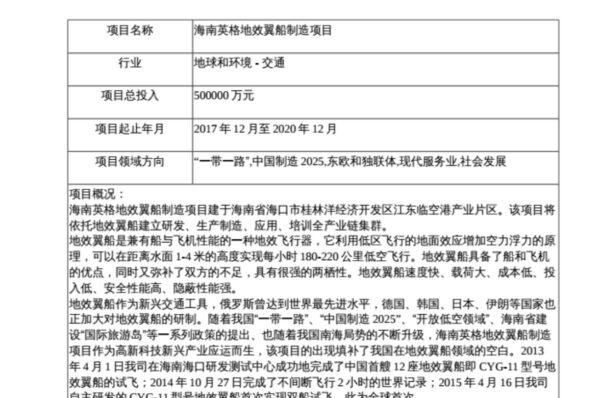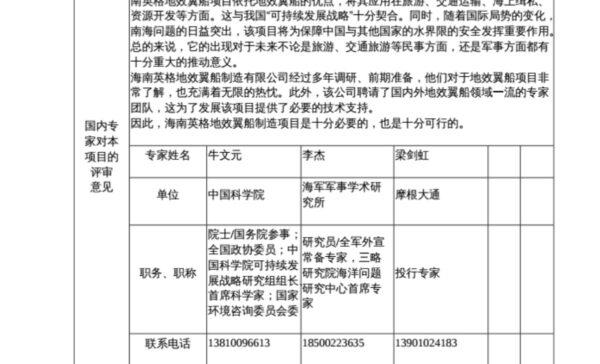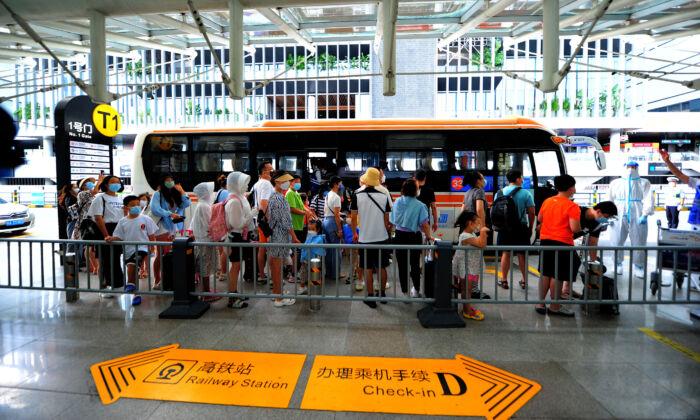The Chinese regime is building a base to design, test, and manufacture ground-effect vehicles (GEV) for the purpose of defending its territorial claims in the South China Sea, according to internal documents The Epoch Times obtained from a trusted source.
A GEV is a type of aircraft-ship hybrid that can skim over the surface of water (ocean or lake), ice, or flat earth.
Beijing claims most of the South China Sea as its own, even after a 2016 international tribunal ruled that such claims were unlawful; the Philippines, Vietnam, Malaysia, Brunei, and Taiwan have competing claims. Home to rich fishing grounds and potentially valuable natural resources, the waterway is also one of the world’s major shipping routes.
The regime has in recent years sought to bolster its claims in the strategic waterway by building military outposts on artificial islands and reefs.
Construction on the GEV base, located in the southern island province of Hainan, began in December 2017 and is slated to be completed in December 2020, according to reports sent by Yingge, the private company contracted to build it, to government authorities.
“Along with changes in the international situation, the issue of the South China Sea is becoming increasingly prominent. The [GEV base] project can play an important role in ensuring the safety of the water boundaries between China and other countries,” Yingge reported to China’s State Administration of Foreign Experts Affairs (SAFEA) on Oct. 27, 2017.

Base
Yingge, based in Haikou city, Hainan, designs and manufactures GEVs. It makes commercialized GEV products, such as the CYG-11, which has been sold to police departments in Chinese cities and countries to patrol waterfront areas.In documents sent to the SAFEA and the Haikou city government by Yingge, the company said the base would host the research, design, and manufacture of the vehicles, the design and testing of applications, and training of pilots and maintenance engineers.
But military expert Rick Fisher doubts the claim.
“A small, flat GEV carrying an anti-ship weapon might escape distant radar detection, but Close In Weapon Systems (CIWS) used by the U.S. Navy that are designed to find and defeat faster and maneuverable anti-ship missiles would likely also detect GEVs,” said Fisher, senior fellow at the Virginia-based International Assessment and Strategy Center.
Fisher suspects that large GEVs could transport troops at high speeds, allowing China’s People’s Liberation Army to “surprise or overwhelm shore defenses on Taiwan” in the event of a conflict with the self-ruled island, which Beijing claims as part of its territory.
If the United States or Japan were to come to Taiwan’s defense, Chinese troops could also be transported to Japan’s Sakashima islands or Okinawa, or the Philippines, where there’s a U.S. naval base, he said.
In the South China Sea, “a large troop-carrying GEV would also be ideal for mounting surprise raids against the smaller South China Sea islands occupied by Vietnam, the Philippines, and Malaysia,” Fisher added.

GEV Development in China
Officially, China developed its first GEV, named the DF-100, in November 1998. It was designed and developed by two state-run companies, China Technology Kaifayuan and China Aerospace Science and Technology Corp., the latter being China’s main contractor for its space program.Over the past two decades, China has developed more GEVs, including a GEV drone developed by a division of China Aerospace that can fly for an hour and a half and carry a one-ton torpedo.
Yingge was established in early 2013 in Haikou. It unveiled the CYG-11 that year, which can carry more than a ton of cargo and fly three to 13 feet above the surface of water at a maximum speed of 130 mph.
While it’s a private company, Yingge has received significant amounts of financial and logistical support from the Chinese regime.
The Hainan branch of the Administration of Foreign Experts Affairs wrote in a January 2018 article in its magazine that the government sent a team to Yingge, supported and guided the company to apply for funding from the central government, and helped arrange visas and residence permits for Russian researchers to assist in GEV development.

Russian Background
In the internal documents, Yingge reported to the central government that a team of Russian researchers who worked on Russian GEVs lent their expertise to the Chinese firm.In the company’s 2016 report, Yingge listed 17 Russian experts, along with their personal information and the subsidies given to them. The central government granted them 2.67 million yuan (about $400,000) in subsidies and allowances. The company didn’t detail how much they were paid in salary.
In 2017, 19 Russian experts were granted 1.254 million yuan ($190,000) in subsidies and allowances.






Friends Read Free